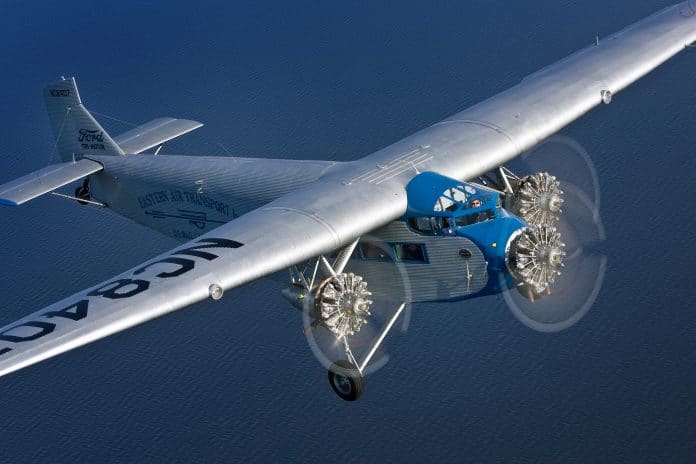Ford Tri-Motor Tour
Recall the energy, passion, and excitement of the Roaring ’20s by flying aboard the Ford Tri-Motor. Known as the first luxury airliner, the Ford Tri-Motor redefined world travel and marked the beginning of a commercial flight.
Henry Ford mobilized millions of Americans and created a new market with his Model T “Tin Lizzie” automobile from 1909 to 1926. After World War I, he recognized the potential for mass air transportation.
Ford’s Tri-Motor aircraft, nicknamed the “Tin Goose,” was designed to build another new market: airline travel. To overcome concerns of engine reliability, Ford specified three engines and added features for passenger comfort, such as an enclosed cabin. The first three Tri-Motors built seated the pilot in an open cockpit, as many pilots doubted a plane could be flown without the direct “feel of the wind.”
From 1926 through 1933, Ford Motor Company built 199 Tri-Motors. EAA’s model 4-AT-E was the 146th off Ford’s innovative assembly line — the 76th model 4-AT-E — and first flew on August 21, 1929. Days later, it was sold to Pitcairn Aviation. When Pitcairn’s management changed hands later that year, NC8407 became the first airplane belonging to Eastern Air Transport, whose paint scheme is replicated on EAA’s Tri-Motor. Eastern Air Transport later became Eastern Airlines.
In 1930, the Tri-Motor was leased to Compañía Nacional Cubana de Aviación Curtiss, where it inaugurated air service between Havana and Santiago de Cuba. The airplane was later flown by the government of the Dominican Republic.
EAA’s Ford Tri-Motor returned to the U.S. in 1949 for barnstorming use. In 1950, it was moved from Miami to Phoenix and was refitted with more powerful engines for use as a crop duster. With two 450-hp engines and one 550-hp engine, it became the most powerful Model 4-AT-E ever flown. In 1955, it was moved to Idaho and fitted with two 275-gallon tanks and bomb doors for use as a borate bomber in aerial firefighting. Then in 1958, it was further modified for use by smokejumpers.
After working for a variety of crop spraying businesses, EAA’s Tri-Motor moved to Lawrence, Kansas, in 1964, where its new owner flew barnstorming tours. During this period, it had a variety of roles, including serving as the primary setting for the Jerry Lewis comedy, The Family Jewels.
In 1973, the aircraft was still being used for air show rides, including an EAA chapter’s fly-in at Burlington, Wisconsin. While at the 1973 fly-in, a severe thunderstorm ripped the plane from its tie-downs, lifted it 20 feet into the air, and smashed it to the ground on its back. EAA subsequently purchased the wreckage.
After an arduous, 12-year restoration process by EAA staff, volunteers, and Ford Tri-Motor operators nationwide, the old Tri-Motor took to the air once again, having its official re-debut at the 1985 EAA Fly-In Convention in Oshkosh.
It was displayed in the EAA AirVenture Museum until 1991 when it returned to its former role of delighting passengers on its annual tour across the U.S.
Flight Experience
The tour stops are hosted by volunteers who are passionate about sharing the Ford Tri-Motor’s stories and it is coming to the Brooksville-Tampa Bay Regional Airport March 5th through the 8th.
They invite families to visit and learn all about their aircraft and organization. Viewing the aircraft is free, so be sure to bring your camera along.
Revenues from the Ford Tri-Motor tour help cover maintenance and operation costs for the aircraft and aid their ambition to keep the “Tin Goose” flying for many years to come.
Each flight experience is approximately 30 minutes, of which about 15 minutes will be in the air. You will need to be seated while the Ford Tri-Motor is airborne; however, each seat is located next to a window. The flights are $72 per adult in advance (walk-up price is $77), $52 per child 17 and under. The EAA’s Ford Tri-Motor 4-AT can carry up to nine passengers at a time and every seat is a window seat.
An adult must accompany children under the age of 16. Children under the age of 2 can be carried free of charge in an adult’s lap.
Access to the airplane is easy and not normally a problem for elderly or mobility-limited people. Two normal-sized steps are used to enter the cabin. Seats are individual (no double seats) and separated by an aisle. Seatbelt extensions are available.
A waiver of liability is required and you can view it on their website. Parents are required to sign a waiver for each minor under the age of 18.
Flights run continuously throughout the day (Thursday 2-5 PM, Friday through Sunday 9 AM-5 PM). Please check-in with our crew onsite as early as possible on the day you wish to fly. Contact a Membership Services Representative at 1-800-359-6217 with any questions or e-mail [email protected].

